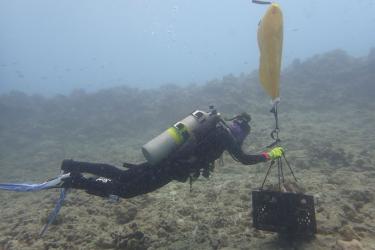Many deepwater and coral reef fish are valuable to commercial fisheries in the U.S. Pacific Islands. Although we know much about these fish from commercial and non-commercial catches, especially their lengths, scientists must also collect samples in the field for more detailed life history. This includes the age and size at which fish mature, how quickly (or slowly!) they grow, and how long they live. The information is used to inform stock assessments, which are the basis for sustainable fishery management.

The NOAA Ship Oscar Elton Sette is the platform for collaborative fisheries research in the Mariana Islands (Photo: NOAA Fisheries).
On June 12, researchers aboard the NOAA Ship Oscar Elton Sette embarked on a fisheries research mission to collect fish life history data along the entire Mariana Archipelago. They are heading to the largely unpopulated northernmost islands, part of the Marianas Trench Marine National Monument. This expedition provides a unique opportunity to study the biology of fish populations in the deep waters (deeper than 200 meters) and shallow coral reefs of remote, unpopulated regions where these fish live free of any local fishing pressure.
From the Deep
The research expedition will use fishery-independent sampling methods to survey and collect deepwater species—snappers, emperors, and groupers—that are fished commercially. Researchers will catch fish with hook-and-line and hydraulic reels. On board the Sette, they will measure each fish and collect samples for further analysis, including:
- Otoliths (ear bones that form rings showing the age of a fish, much like tree trunks do of trees).
- Gonads (reproductive organs that show a fish’s sexual maturity).
- Genetic material (which shows how fish populations are connected between the islands).

Tropical deepwater fisheries target a wide variety of species; most are poorly studied in terms of basic biology, which is foundational to our understanding of fisheries dynamics. During SE-18-02, researchers will study the life history of deepwater etelis snappers and mesophotic commercial fishes using their otoliths (for age information) and gonads (for reproductive information).
To the Reef
The mission will also study six species of shallow-water reef fish—lined surgeonfish, orangespine unicornfish, bluefin trevally, bluespine unicornfish, big-eye bream, redlip parrotfish, and bullethead parrotfish—that are fished commercially. These species are important targets for the nearshore commercial fisheries of the Mariana Islands.

Lined surgeonfish (Acanthurus lineatus) (Photo: NOAA Fisheries/Ray Boland).
In the Environment
Scientists will collect conductivity (salinity), temperature, and depth measurements to get an overview of the oceanographic conditions and support ongoing research of the high productivity at remote islands. In addition, water samples will be collected and analyzed for environmental DNA. Environmental DNA provides a snapshot of all species that are interacting in the coral reef environment.

Small boats launched from the NOAA Ship Sette are used to collect fish samples for life-history studies (Photo: NOAA Fisheries).
For the Region
The research will greatly complement ongoing data collections from the Marianas- and Guam-based commercial fisheries biosampling programs.
This effort represents a collaboration between the Pacific Islands Fisheries Science Center’s Life History Program and the CNMI Department of Lands and Natural Resources, Division of Fish and Wildlife. Other organizations participating in the expedition and collaborating on research projects include the University of Guam, Micronesian Environmental Services, the Australian Museum, and King Abdullah University of Science and Technology.



